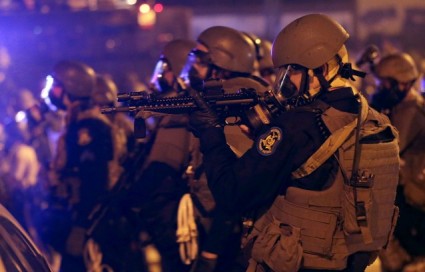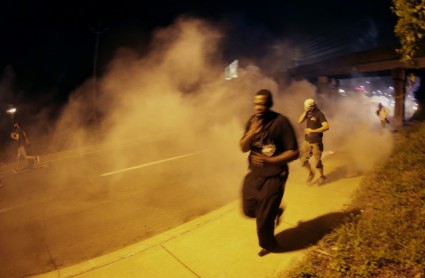What The Police’s ‘Non Lethal Weapons’ Can Do To Human Bodies
by Tara Culp-Ressler – 18 August – Think Progress

Police advance after tear gas was used to disperse a crowd of protesters in Ferguson, MO on Sunday – AP Photo/Charlie Riedel
The ongoing unrest in Ferguson over 18-year-old Mike Brown’s shooting has illustrated the increasingly blurry line between law enforcement and military combat, as heavily armed police forces in riot gear have repeatedly clashed with unarmed protesters. On Sunday night, that tension was on full display, and police reportedly fired tear gas and rubber bullets into the crowds well before the town’s midnight curfew.
U.S. police are increasingly relying on those so-called “non lethal weapons” for crowd control, a dynamic that’s inspired a national conversation about whether it’s appropriate to arm cops with weapons that are typically used in combat. Indeed, there’s increasing evidence that non lethal weapons can actually inflict serious pain and, in some rare cases, even kill people. Here’s how the police in Ferguson are potentially putting protesters’ health in danger:

People run from tear gas after police dispersed protesters in Ferguson on Sunday night – AP Photo/Charlie Riedel
Although tear gas is a chemical agent that’s banned in warfare, it’s perhaps the most common method of crowd control at protests around the world. Tear gas activates pain receptors in the body, causing a sensation of burning in subjects’ eyes, noses, and throats. In response to the pain, victims typically cough and choke, and their bodies produce excessive tears and mucous in an attempt to flush out the chemical. Because there are so many pain receptors in the cornea, it’s usually impossible for them to keep their eyes open, and some people report temporary blindness. People who suffer from asthma, or people who have been sprayed with tear gas in an enclosed space, often struggle to breathe.
Although tear gas is classified as non lethal because it’s generally considered to have only short term consequences, some scientists warn that things can quickly go wrong if it’s deployed incorrectly. There have been several reports of people dying in Egypt and Israel after inhaling too much tear gas.
Opponents of this particular chemical agent point out that there hasn’t been enough conclusive research into its potential long term health effects. Physicians for Human Rights has documented several cases in which people in Bahrain have suffered miscarriages, respiratory failure, and persistent blindness after being exposed to tear gas. The Chilean government suspended the use of tear gas in 2011 over concerns that the chemicals could damage women’s reproductive systems and harm their fetuses.
“These agents are certainly not benign,” Sven-Eric Jordt, a professor of pharmacology at Yale University School of Medicine, told the National Geographic in an interview last year. “There is no way to disconnect the pain that is induced from the physiological inflammatory effects of these agents.” …more
Comments are closed.